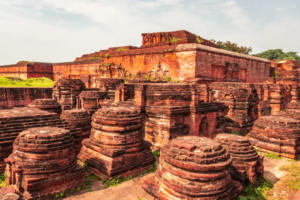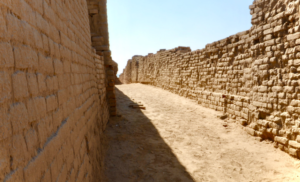Introduction
Mohenjo-Daro, an ancient city of the Indus Valley Civilization, stands as a testament to early human innovation and culture. Located in Sindh, Pakistan, there is one of the world’s most significant archaeological sites. The city dates back to around 2500 BCE, showcasing remarkable urban planning and social organization. Today, it gives us invaluable insights into the lives, culture, and achievements of one of humanity’s earliest advanced civilizations.
Historical Significance
Mohenjo-Daro represents a major urban center of the Indus Valley Civilization. This ancient city thrived thousands of years ago and contributed significantly to South Asia’s cultural and social heritage. Historians believe once housed up to 40,000 people. This vibrant population lived harmoniously, with a well-organized society that valued hygiene, architecture, and community life. The site reflects an advanced understanding of city planning and engineering, which was rare for that era.
Architectural Marvels
Mohenjo-Daro’s architecture highlights the skill and ingenuity of its builders. The city had a carefully planned layout, with main streets and narrow lanes intersecting at right angles. This grid-like structure showed an understanding of efficient city design. Houses in Mohenjo-Daro had baked brick walls, an innovation at the time. The most famous structure in the city is the Great Bath, a large public water tank. Experts believe that the people of Mohenjo-Daro used the Great Bath for religious or social gatherings. Public buildings, granaries, and a complex drainage system further illustrate the city’s advanced urban planning.
Cultural Aspects
Artifacts found at Mohenjo-Daro reveal the city’s rich culture and daily life. Archaeologists have discovered pottery, jewelry, toys, and tools, which show the residents’ skills in crafting and creativity. They also found seals, featuring animal motifs and symbols, which may have held religious or administrative significance. These seals suggest that had a unique symbolic language or script, although it remains undeciphered. From their intricate designs and ornaments, we see how people took pride in their appearance and lifestyle.
Agriculture and Economy
Mohenjo-Daro’s economy relied heavily on agriculture, trade, and craftsmanship. The fertile lands around the Indus River supported crop cultivation, allowing the people to grow wheat, barley, and other grains. They also domesticated animals like cattle, sheep, and goats. Trade played a vital role in prosperity. The city engaged in trade with nearby regions, and possibly even with far-off places like Mesopotamia. Artifacts from distant lands found in the hint at a thriving exchange of goods, culture, and ideas.
Social Structure
 The social organization in Mohenjo-Daro was likely complex and structured. Archaeological evidence suggests that the city had different classes or roles within society. People lived in both large and small homes, hinting at some form of social hierarchy. The presence of large public buildings indicates central governance or communal decision-making. This social organization allowed the people to maintain order, cleanliness, and unity, further reflected in the city’s meticulous planning.
The social organization in Mohenjo-Daro was likely complex and structured. Archaeological evidence suggests that the city had different classes or roles within society. People lived in both large and small homes, hinting at some form of social hierarchy. The presence of large public buildings indicates central governance or communal decision-making. This social organization allowed the people to maintain order, cleanliness, and unity, further reflected in the city’s meticulous planning.
Decline and Legacy
The decline of Mohenjo-Daro remains one of history’s unsolved mysteries. Scholars have suggested several theories, including climate change, river shifts, and invasions, but no definitive cause has been established. Despite its decline, the city left a lasting impact on the region and on future civilizations. The sophisticated lifestyle, trade practices and urban design of it’s influenced many South Asian cultures that followed. Today, there is stands as a symbol of human resilience, innovation, and cultural heritage.
Visiting
Today is a UNESCO World Heritage site and a vital part of Pakistan’s cultural identity. Despite its age, the site attracts thousands of tourists and historians each year. Conservation efforts aim to protect the ancient ruins from further damage. Visitors can explore the city’s remaining structures and imagine life as it was thousands of years ago. By visiting, one gains a deeper appreciation for early civilization and its enduring influence on human history.
Conclusion
There is represents an incredible chapter in the story of human civilization. Its urban planning, cultural sophistication, and mystery make it an essential piece of world heritage. The city’s ancient ruins continue to captivate and inspire, reminding us of our shared history and the remarkable achievements of our ancestors. As we explore Mohenjo-Daro, we not only learn about the past but also gain insight into the foundations of our own societies.
FAQs about Mohenjo-Daro
Q1: What does “Mohenjo-Daro” mean?
A1: “Mohenjo-Daro” translates to “Mound of the Dead” in the Sindhi language. This name reflects the city’s ancient ruins and the mystery surrounding its decline.
Q2: When was Mohenjo-Daro discovered?
A2: British archaeologist Sir John Marshall discovered Mohenjo-Daro in 1922. The excavation revealed a well-preserved ancient city, leading to major insights into the Indus Valley Civilization.
Q3: Why is Mohenjo-Daro important?
A3: Mohenjo-Daro is important because it showcases advanced urban planning, social organization, and cultural achievements of the Indus Valley Civilization. It helps historians understand early human development.
Q4: Can people visit Mohenjo-Daro today?
A4: Yes, people can visit Mohenjo-Daro today. It is a UNESCO World Heritage site and remains open for tourism, though conservation efforts are in place to protect its ruins.
Q5: What is the Great Bath in Mohenjo-Daro?
A5: The Great Bath is a large, water-tight tank built. Experts believe it was used for ritualistic purposes, social gatherings, or religious ceremonies.